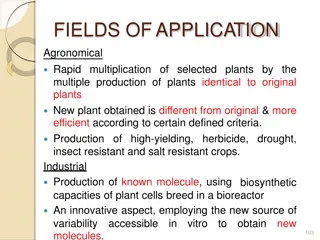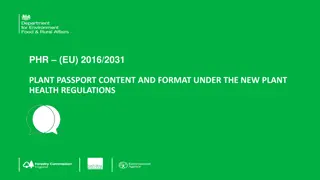Understanding Plant Chemistry and Phytonutrients: Insights from Research
Exploring the diverse world of plant chemistry, this content delves into primary and secondary metabolites, highlighting the significance of phytonutrients in maximizing nutritional content. Various hypotheses such as the Insecticide Hypothesis and Co-evolution Hypothesis are discussed, shedding light on the interplay between plants and their environment. The Carbon/Nutrient Balance Hypothesis, Growth Rate Hypothesis, and Growth/Differentiation Balance Hypothesis provide further insights into how plants regulate their secondary metabolite production. This comprehensive analysis emphasizes the importance of secondary metabolites in plant growth and defense mechanisms.
Download Presentation

Please find below an Image/Link to download the presentation.
The content on the website is provided AS IS for your information and personal use only. It may not be sold, licensed, or shared on other websites without obtaining consent from the author. Download presentation by click this link. If you encounter any issues during the download, it is possible that the publisher has removed the file from their server.
E N D
Presentation Transcript
Maximizing phytonutrient content: Research and perspective Guido Mase 2016
Plant chemistry: - Primary metabolites - Proteins (structure/enzyme) - Carbs (energy) - Fats (energy storage)
Plant chemistry: - Secondary metabolites - Phenolics - Terpenoids - Alkaloids - and more!
Insecticide hypothesis: Dethier 1954 Fraenkel 1959
Co-evolution hypothesis: Erlich & Raven 1964
Co-evolution hypothesis: Erlich & Raven 1964
Carbon / nutrient balance hypothesis: Secondary metabolites are often hydrocarbons, rich in carbon When abundant nutrients are available, growth is preferred (primary met) When nutrients are low, carbon metabolism increases (secondary met) Bryant 1983
Growth rate hypothesis: As growth rate decreases, secondary metabolites increase Coley 1985
Growth/Differentiation Balance hypothesis: If growth rate decreases, but photosynthesis stays high, carbon is diverted to secondary metabolites. Wilkens 1996, 1997
Weve known about this bell curve of secondary plant metabolite production for a long time. Jonathan Gershenzon 1985: Phytochemical Adaptations to Stress Most likely all secondary plant metabolite production hypotheses are interrelated and relevant. But I d like to propose another to add:
Is it really an arms race? No. We re working together to support each other and the ecology
Bioflavonoids (such as morin) First produced when plants emerged from the ocean. UV protection, reduces DNA damage Had initial browsing deterrent effects Later, co-evolution often led to these molecules becoming useful mediators of symbiotic connections NOW, we depend on them!
Bioflavonoids (such as morin) First produced when plants emerged from the ocean. UV protection, reduces DNA damage Had initial browsing deterrent effects Later, co-evolution often led to these molecules becoming useful mediators of symbiotic connections NOW, we depend on them! High bioflavonoid intake = lower rates of chronic disease Knekt 2002
Bioflavonoids (such as morin) First produced when plants emerged from the ocean. UV protection, reduces DNA damage Had initial browsing deterrent effects Later, co-evolution often led to these molecules becoming useful mediators of symbiotic connections NOW, we depend on them! High bioflavonoid intake = lower rates of breast cancer Shu 2009 (JAMA) follow-up in 2012 (Am. Journ. Clinical Nutrition) - Specifically for isoflavones, a secondary metabolite in legumes
Isoflavones: Necessary signals for nitrogen-fixing bacteria to colonize legume roots Rolfe 1998
Isoflavones: Carefully choreographed dance between plant and bacteria, with plant secondary metabolites as choreographers. Subramanian 2007
Isoflavones: By eliminating an isoflavone reductase gene, nodulation is severely impaired Ripodas 2013
Secondary plant metabolites are bioremediation agents: Clear polycyclic aromatic hydrocarbons (Chen & Aitken 1999) Metabolize and clear PCBs (Singer 2000) degradation, not bioaccumulation, via coordination of microbial metabolism and activity!
Secondary plant metabolites are bioremediation agents: Even ground-up plant material rich in secondary metabolites cleans the soil: pine needles, orange peel, ivy leaves (Hernandez 1997) degradation, not bioaccumulation, via coordination of microbial metabolism and activity!
Plant secondary metabolites: - Not for war - Way more than just defense - Health benefits not a coincidence ! - Cross-kingdom signals used to choreograph ecological function
Plant secondary metabolites: - They are essential! - Problem: Almost universally, these molecules are bitter-tasting
Over time, we have: - Bred plants to taste less bitter - Stimulated growth with extra fertility
Results: - Lower phytonutrient density - Primary metabolites / yield have been favored Jo Robinson, 2013
Results: - Wild olive trees have consistently greater polyphenol content (but lower yields!) Giovanna Massei, 2000
Christina Warinner, 2013 TEDEx talk: Debunking the paleo diet
We need a different approach: Perhaps different cultivation ideas geared less to high yield Plants as partner, not commodity
Secondary plant metabolites are induced by stress: Pine, Artemisia annua, basil Turtola 1995
Secondary plant metabolites are induced by stress: But excessive stress so minimizes yields as to be impractical (and less chemistry overall) Weiss 1997
Increasing CO2 in the environment increases secondary plant metabolite production Zobayed 2003
Decreasing water leads to a 70-fold increase in some metabolites, 2.5x more antioxidant capacity Zobayed 2005, Charles 2005
Decreasing water consistently elevates secondary metabolites in an inverse relationship Aznar 2011
Decreasing water consistently elevates secondary metabolites in an inverse relationship Aznar 2011
Sage grown in more arid conditions has higher concentrations of secondary metabolites, especially terpenes Selmar 2008
Decreasing water available to sage plants elevates the concentrations of secondary metabolites reliably and consistently Selmar 2013
Decreasing water available to sage plants elevates the concentrations of secondary metabolites reliably and consistently (old leaves and young leaves) Selmar 2013
Effects of drought stress and/or nutrient deprivation stress on phytonutrients
Effects of drought stress and/or nutrient deprivation stress on phytonutrients
Effects of drought stress and/or nutrient deprivation stress on phytonutrients
UV Radiation stress: Gotu Kola produces more bioflavonoids and saponins in response to moderate UV stress Muller 2013
Role of fertilizers / nutrients: Higher levels of nitrogen and phosphorus reduce secondary metabolite production (particularly in rhizosphere less mycorrhizal cross-signaling molecules) Yoneyama 2013
Role of fertilizers / nutrients: But good levels of potassium seem to be important for medicinal plants to weather stress effectively, maintain phytonutrient levels Devi 2011























